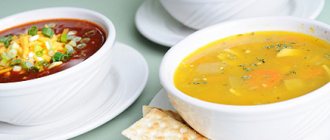Anyone who carefully monitors their diet sooner or later asks the question: “How to correctly calculate the calorie content of a particular soup?” Using chicken soup as an example, we manually calculate the number of calories in one serving.
The calculation method is suitable for those who prepare the first courses themselves and know the grams of ingredients included in it. But it happens that we eat in canteens or cafes; for such cases, the “Soup Calorie Table”, which you will find below, with average values, will help you. Of course, it’s not ideal, but rather than not recording the kcal consumed at all, it’s better to use ready-made calculations.
“Vegetable soup” - in more detail:
- Vegetable soup with beef
- Canned vegetable soup with beef
- Concentrated vegetable soup with beef
- Canned vegetable soup with beef
- Concentrated vegetable soup with beef
- Concentrated vegetable soup with broth
Useful properties of soups
Soups are good for the human body. They stimulate digestion, are easy to digest and contain trace elements and vitamins, and also saturate the body well.
In addition, soups contain minimal calories, so they are excellent for both dietary nutrition and for nursing sick people. Some soups, for example, chicken broth or fish soup, help with viral diseases. They soften coughs, strengthen the body and even act as an antipyretic.
Many soups contain minimal calories, but if you add pasta, cereals and fats, the calorie content of soups will increase significantly. If we talk about meat broths, then in such soups the calories increase slightly. In addition to the low calorie content of soups, they nourish our body with microelements, vitamins and ballast substances.
Soups contain water, which is necessary for the human body. Vegetable fiber is easily digested due to heat treatment. But you should remember that the longer the soup is cooked, the less beneficial substances will remain in it.
Soups help prevent the development of stomach cancer and are a preventive measure for cardiovascular diseases.
During the cold season, soups are considered the best food. They warm, improve metabolism, and give the human body energy and warmth.
Related Products
Chili soup (57 cal) Carrot coriander soup (100 cal) Lentil soup (54 cal) Clear soup (8 cal) Chicken soup (60 cal) Potato soup (63 cal) Mushroom soup (51 cal) ) Tomato soup (43 cal) Bean soup (74 cal) Fish soup (16 cal) Turtle soup (53 cal) Onion soup (44 cal) Noodle soup (35 cal) Beef soup (50 cal) Pea Soup (67 cal) Vegetable Pasta Soup (44 cal) Broccoli Soup (60 cal) Homemade Soups (22 cal) Turkey Soup (38 cal) Cream Soups (52 kcal.) Meat soup (50 kcal.) Oyster stew soup (40 kcal.) Chinese soup (33 kcal.) Shark fin soup (46 kcal.) Cheese soup (76 kcal.)
Secrets on how to reduce the calorie content of soup
Body weight directly depends on the nutritional value of the soups consumed.
Nutritionists have calculated that a daily decrease in the energy value of a dish by just 100 kcal prevents the appearance of 1 kg of excess weight per year.
There are several simple rules, following which you can get rid of 500 grams of fat every week.
Cook with low-calorie foods
Many dishes will not lose their taste (or gain it) if their ingredients are changed.
For example, you can safely change components:
- whole milk – low-calorie;
- butter - olive oil or any vegetable oil;
- fatty meat (sausage, ham) - fish or lean veal;
- cereals - for vegetables and herbs;
- mayonnaise - for natural yogurt;
- sugar – for fructose, etc.
Important! It is advisable not to use starch, potatoes, rice, flour, sugar, seasonings with a high salt content, or canned foods when preparing dishes.
Do not fry vegetables
Fried food adds at least 150 kcal to each soup. An alternative is raw or steamed vegetables.
Be sure to read: Onion soup diet for weight loss for a week, 10 days
Use skinless meat
Any soup is a source of energy and strength.
The main source of carbohydrates and fats is not contained in the chicken pulp itself, but in its skin. When cooking meat, the skin must be removed.
Avoid fatty sauces
A good alternative to mayonnaise, full-fat sour cream and ketchup would be mustard, lemon or homemade pesto sauce with garlic and basil, natural yogurt, balsamic vinegar, etc.
Drain the first broth
When cooking broth, the first portion must be drained - it is full of antibiotics and chemicals that the animal consumed along with the food. The second broth is healthier and cleaner.
Do not use sour cream
Sour cream is a fairly fatty product. It is best to replace it with natural yogurt, mustard or homemade tomato paste.
Composition of nutrients, BJU
Vegetable soup
| For quantity: 100 grams | ||
| Calories — 41 | Calories from fat - 3 | |
| BJU | ||
| Total fat content | 0.3g | |
| Saturated | 0.1g | |
| Polyunsaturated | 0g | |
| Monounsaturated | 0g | |
| Cholesterol | 0mg | |
| Total carbohydrate content | 8.25g | |
| Dietary fiber | 1.18g | |
| Sugar | 3.39g | |
| Squirrels | 1.18g | |
| Vitamins and microelements | ||
| A - 0mcg | C - 0.1 mg | |
| B-6 – 0mg | B-12 - 0mcg | |
| D - 0mcg | E - 0mg | |
| Calcium 16 µg | Iron 0.32mg | |
| Magnesium 0mg | Zinc 0mg | |
| Potassium 308 mg | Sodium 254 mg | |
Distribution of calories for BJU:Carbohydrates (83%) Fats (6%) Proteins (11%) | ||
Calorie tables for foods used in preparing first courses
Meat, meat by-products and poultry
| Meat, meat by-products and poultry | Calorie content per 100 g (kcal) | Meat, meat by-products and poultry | Calorie content per 100 g (kcal) |
| Fatty lamb | 316 | Pork liver | 107 |
| Lamb meat | 206 | Lamb kidneys | 76 |
| Ham | 365 | Beef kidneys | 59 |
| Beef udder | 172 | Pork kidneys | 79 |
| Boiled lean beef | 110 | Beef sausages | 215 |
| Fried beef | 170 | Pork sausages | 332 |
| Fatty boiled beef | 205 | Fried pork | 275 |
| Beef stew | 180 | Pork is fatty | 390 |
| Brisket | 300 | Pork lean | 315 |
| Goose | 490 | Stewed lean pork | 245 |
| Turkey | 205 | Pork chop | 265 |
| Boiled sausage | 250 | Pork skinny | 259 |
| Diabetic sausage | 254 | Pork stew | 350 |
| Krakow sausage | 382 | Lamb heart | 76 |
| Amateur sausage | 291 | Beef heart | 87 |
| Moscow sausage | 463 | Pork heart | 89 |
| Sausage separate | 193 | Sausages | 266 |
| Semi-smoked sausage | 380 | Roasted veal | 150 |
| Ukrainian sausage | 404 | Fatty veal | 148 |
| horsemeat | 143 | Boiled veal | 115 |
| Korean | 469 | Skinny veal | 89 |
| Rabbit | 183 | Duck | 345 |
| Boiled chicken | 135 | Chickens | 146 |
| Fried chicken | 210 | Chicken egg (1 pc.) | 157 |
| Boiled fatty chicken | 195 | Beef tongue | 165 |
| Lean boiled chicken | 135 | Pork tongue | 208 |
| Beef brains | 123 | Chicken raw | 189 |
| Lamb liver | 100 | Chicken thigh raw | 181 |
| Beef liver | 87 | Chicken breast raw | 111 |
| Chicken wings raw | 186 |
See also: How to quickly cook beans for soup
Fish and seafood
| Fish and seafood | Calorie content per 100 g (kcal) | Fish and seafood | Calorie content per 100 g (kcal) |
| Gobies | 144 | Cod liver | 610 |
| Pink salmon | 147 | Blue whiting | 72 |
| Chum salmon caviar | 245 | Cancers | 75 |
| Red caviar | 256 | Saber fish | 110 |
| Breakout bream caviar | 142 | Caspian fisherman | 98 |
| Pollock caviar | 130 | Carp | 121 |
| Granular caviar | 250 | Saira | 182 |
| Sturgeon caviar punched | 235 | Salaka | 119 |
| Black caviar (beluga, sturgeon) | 280 | Stellate sturgeon | 137 |
| Squid | 74 | Herring | 246 |
| Flounder | 87 | Atlantic herring | 57 |
| Fried flounder | 75 | Salted herring | 261 |
| Smoked flounder | 90 | Sardines in oil | 275 |
| crucian carp | 87 | Pickled herring | 155 |
| Boiled carp | 95 | Smoked herring | 218 |
| Fried carp | 145 | Fried herring | 180 |
| Chum salmon | 138 | Salmon | 219 |
| Canned fish in oil | 320 | Whitefish | 143 |
| Canned fish in its own juice | 120 | Mackerel | 153 |
| Smelt | 90 | Som | 143 |
| Crabs | 68 | Horse mackerel | 119 |
| Shrimps | 97 | Sterlet | 122 |
| Icy | 74 | Zander | 83 |
| Bream | 105 | Boiled pike perch | 30 |
| Tench | 40 | Trepang | 37 |
| Fried salmon | 145 | Cod | 75 |
| Smoked salmon | 385 | Boiled cod | 44 |
| Macrurus | 60 | Tuna | 101 |
| Lamprey | 165 | Tuna in oil | 300 |
| Pollock | 69 | coal fish | 157 |
| capelin | 157 | Acne | 332 |
| Sea kale | 17 | Sea eel | 93 |
| Navaga | 73 | Boiled trout | 45 |
| Burbot | 80 | Hake | 86 |
| Marbled notothenia | 155 | Sprats in oil | 250 |
| Sea bass | 117 | Pike | 81 |
| River perch | 82 | Fried pike | 95 |
| Sturgeon | 163 | Boiled pike | 45 |
| Halibut | 102 | Ide | 81 |
Milk and dairy products
| Milk and dairy products | Calorie content per 100 g (kcal) | Milk and dairy products | Calorie content per 100 g (kcal) |
| Acidophilus (3.2% fat) | 58 | Sour cream 10% fat | 113 |
| Cow cheese | 260 | Sour cream 20% fat | 204 |
| Yogurt (1.5%) | 51 | 30% fat | 293 |
| Full fat kefir | 60 | Dutch cheese | 357 |
| Kefir (1% fat) | 38 | Lambert cheese | 377 |
| Low-fat kefir | 28 | Parmesan cheese | 330 |
| Curd mass | 345 | Processed cheese | 501 |
| Acidophilus milk | 83 | Poshekhonsky cheese | 446 |
| Milk (3.2% fat) | 58 | Russian cheese | 371 |
| Milk (1.5% fat) | 44 | Sausage cheese | 268 |
| Whole cow's milk | 68 | Swiss cheese | 433 |
| Skim milk | 31 | Curd cheeses | 380 |
| Condensed milk | 137 | Cottage cheese (18% fat) | 226 |
| Condensed milk with sugar | 329 | Fat cottage cheese | 223 |
| Whole milk powder | 485 | Low-fat cottage cheese | 80 |
| Ice cream | 220 | Cottage cheese semi-fat | 153 |
| Curdled milk | 59 | Cottage cheese with sour cream | 260 |
| Ryazhenka | 85 | Cream 20% fat | 205 |
| Cream 10% fat | 118 |
Vegetables, herbs and mushrooms
| Vegetables greens mushrooms | Calorie content per 100 g (kcal) | Vegetables greens mushrooms | Calorie content per 100 g (kcal) |
| Eggplant | 28 | Leek | 41 |
| Swede | 38 | Bulb onions | 43 |
| Fresh porcini mushrooms | 25 | Carrot | 33 |
| Dried porcini mushrooms | 211 | Fresh cucumbers | 15 |
| Boiled mushrooms | 25 | Pickles | 8 |
| Mushrooms in sour cream | 230 | Olives | 519 |
| Fried mushrooms | 165 | Parsnip | 38 |
| Fresh boletus mushrooms | 32 | Sweet green pepper | 19 |
| Fresh boletus mushrooms | 31 | Sweet red pepper | 28 |
| Fresh russula mushrooms | 15 | Parsley (greens) | 47 |
| Honey mushrooms | 20 | Parsley (root) | 50 |
| boletus | 30 | Tomatoes | 20 |
| Boletus | 30 | Rhubarb | 16 |
| Green pea | 75 | Radish | 16 |
| Green bean | 33 | Radish | 25 |
| Zucchini | 18 | Turnip | 23 |
| White cabbage | 23 | Salad | 11 |
| Brussels sprouts | 12 | Beet | 40 |
| Sauerkraut | 28 | Pumpkin | 20 |
| Red cabbage | 27 | Dill | 30 |
| Cauliflower | 18 | Horseradish | 49 |
| Jacket potatoes | 96 | Cheremsha | 35 |
| Boiled potatoes | 120 | Garlic | 60 |
| Baked potatoes | 215 | Spinach | 16 |
| Green onion | 18 | Sorrel | 27 |
See also: Making complex soups
Cereals and legumes
| Cereals, pulses and legumes | Calorie content per 100 g (kcal) | Cereals, pulses and legumes | Calorie content per 100 g (kcal) |
| Beans | 58 | Wheat groats | 352 |
| Hercules | 371 | Barley groats | 343 |
| Green peas | 280 | Cornflakes | 369 |
| Peas | 337 | Pasta | 350 |
| Whole peas | 316 | Cereals | 305 |
| Wheat flour 1st grade | 346 | Millet | 350 |
| Wheat flour 2 grades | 346 | Millet | 351 |
| Premium wheat flour | 346 | Whole wheat | 262 |
| Rye flour | 347 | Rice | 337 |
| Cocoa powder | 375 | Rye | 330 |
| Buckwheat | 346 | Soybeans | 395 |
| Corn grits | 344 | Oatmeal | 374 |
| Semolina | 340 | Beans | 328 |
| Oatmeal | 374 | Lentils | 310 |
| Pearl barley | 342 | Barley flakes | 315 |
Oils, fats, eggs and sauces
| Oils, fats, eggs and sauces | Calorie content per 100 g (kcal) | Oils, fats, eggs and sauces | Calorie content per 100 g (kcal) |
| Rendered beef fat | 871 | Corn oil | 900 |
| Rendered animal fat | 897 | Olive oil | 824 |
| Pork fat | 871 | Sunflower oil | 900 |
| Rendered fat | 930 | Vegetable oil | 899 |
| Pork fat | 821 | Butter | 750 |
| Ketchup | 80 | Soybean oil | 900 |
| Mayonnaise | 625 | Nut butter | 570 |
| Light mayonnaise | 260 | Ghee | 885 |
| Milk margarine | 745 | Protein powder | 337 |
| Creamy margarine | 745 | Dry yolk | 624 |
| Sandwich margarine | 670 | Egg powder | 544 |
| Margarine for baking | 675 | Chicken egg | 157 |
| Quail egg | 167 |
Borsch
Approximate calorie content:
49 kcal per 100 grams.
Photo: istockphoto.com
Borscht cannot be called a harmful dish, but it is difficult for the stomach to digest an overly rich broth. Therefore, instead of meat, it is better to use vegetable. The Ukrainian dish is usually prepared with potatoes, which are rich in starch. And this can cause excess weight. It is best to cook borscht with new potatoes and add them 20 minutes before the end of cooking.
Sports without leaving home. 4 ideas for variety of leisure time within four walls
And a little about secrets.
The story of one of our readers, Inga Eremina:
I was especially depressed by my weight; at 41, I weighed as much as 3 sumo wrestlers combined, namely 92 kg. How to completely lose excess weight? How to cope with hormonal changes and obesity? But nothing disfigures or makes a person look younger than his figure.
But what can you do to lose weight? Laser liposuction surgery? I found out - no less than 5 thousand dollars. Hardware procedures - LPG massage, cavitation, RF lifting, myostimulation? A little more affordable - the course costs from 80 thousand rubles with a nutritionist consultant. You can, of course, try to run on a treadmill until you go crazy.
And when will you find time for all this? And it's still very expensive. Especially now. Therefore, I chose a different method for myself.
Benefits of cabbage soup
The beneficial properties of cabbage soup include:
- Despite its low calorie content, cabbage soup perfectly satisfies the feeling of hunger. Such soups are often included in the diet during weight loss and dieting;
- sour cabbage soup is saturated with vitamin C, iron, phosphorus, sodium, silicon, calcium, potassium and other vitamins and minerals;
- soup stimulates the functioning of the stomach, intestines, pancreas, and gall bladder;
- the product normalizes metabolism, ensuring effective weight loss;
- With regular consumption of cabbage soup, the level of bad cholesterol decreases and blood sugar levels normalize;
- It is recommended to eat soup to prevent constipation.
Pumpkin ginger soup
A spicy and very aromatic soup will warm you up on cold evenings and significantly strengthen your immune system.
Ingredients:
- Ginger root - 1/2 pcs.
- Worcestershire sauce - 1/2 tsp.
- Garlic – 7 cloves
- Butter - 70 g
- Carrots - 2 pcs.
- Coriander - 1 tsp.
- Red onion - 1 pc.
- Pumpkin – 500 g
- Cilantro - 1 bunch
Preparation:
Cut the pumpkin and carrots into large pieces.
You need to choose porridge varieties of pumpkin - it is much tastier and more aromatic.
Chop garlic, cilantro, ginger root and onion.
Place vegetables in pan, drizzle with melted butter and sprinkle with herbs and spices. Drizzle with Worcestershire sauce.
Stir and bake vegetables.
Pour the prepared vegetables with the required amount of water and boil.
Blend the dish in a blender and serve, sprinkled with cilantro.
Recommended storage methods
The prepared soup should not be left at room temperature for more than 2 hours (1 hour if the weather is very hot). Then you need to put it in the refrigerator or freeze it. Otherwise, dangerous bacterial growth may occur. If you intend to freeze the soup, chill it all in the refrigerator first - this way you will retain maximum nutritional value. Place leftover food after eating into a new container. Do not store them in the pan where they were boiled.
Contacts
Representative office of Bonduelle Central Europe Co. Ukraine, 01135, Kyiv, st. Dmitrievskaya, 75, office 172
Buckwheat soup without meat
To prepare buckwheat soup, it is not necessary to use meat products to make it tasty and healthy, especially if a person is fasting or a vegetarian. This soup is also useful for people who are overweight or watching their figure. To do this, you will need the usual ingredients in addition to buckwheat:
- vegetable oil;
- onions, salt;
- carrots and potatoes;
- black pepper and bay leaf;
- water depending on the amount of previous ones;
- greens are added at discretion.
Peeled and diced potatoes, filled with water in a saucepan, are placed on the device for further production. To reduce the calorie content of the soup, you can use celery root instead of potatoes.
Cheese soup with potatoes and carrots
According to experts, the Czech Republic and Slovakia are considered the birthplace of cheese soup due to the preparation of the national dish. Cheese soup has gained popularity for its variety of recipes and because of its quick, easy preparation. The choice of products for cheese soup has an extensive selection:
- cheese product of any kind, excluding curd;
- various spices, herbs and vegetables;
- sausages;
- shrimp, mushrooms, chicken and eggs;
- rice, sour cream, flour and butter.
The preparation of this soup depends on your imagination during preparation. Most recipes contain a large number of calories, which can harm not only your figure, but also your health. How to choose the right cheese soup recipe without any consequences. To do this you will need:
- Peeled potatoes, cut into small pieces.
- Carrots, coarsely grated.
- Diced peeled onion.
Simmer all ingredients in vegetable oil for 5-10 minutes, then add a little water, bring to a boil and add processed cheese. The soup should be stirred until the cheese is completely dissolved and cooked until fully cooked.
The dish poured into plates can be decorated with herbs at your discretion and it is not recommended to store it for a long time.
Cabbage soup and diet
Having found out how many calories are in cabbage soup with meat, you can decide that there is nothing dangerous in the dish. Even if your portion is 300 g, it only contains 165 kcal, which is more than acceptable for lunch. However, nutritionists warn that cabbage soup made with beef is dangerous not so much in terms of calories as in its fat content. If you do not want to replace beef with chicken or turkey (remember that you need to remove the skin from them), boil the meat and transfer it to fresh water: this is where the broth will be prepared. The soup will not be as rich, but also easier on the digestive system.
The best option for the diet is cabbage soup made from sorrel or nettle without meat broth: they contain only 18-20 kcal. True, they cannot be called very nutritious.
However, even if you plan to cook a dish exclusively with beef and don’t even want to make a secondary broth, but use the first water, you will still get some benefit. Cabbage, which forms the basis of cabbage soup, has a positive effect on metabolic processes, promotes the breakdown of fats and quickly saturates. Increase its share in the recipe and remove the potatoes and there will be no threat to your figure.
Also, so that cabbage soup does not interfere with weight loss, remember a few recommendations:
- Consume the dish only before 18 o'clock.
- Do not fry vegetables before adding to soup.
- Do not add sour cream to the cabbage soup and refuse bread.
And to enhance the fat-burning effect, experts advise cooking cabbage soup not with fresh cabbage, but with sauerkraut: the vinegar with which it is soaked has a positive effect on metabolic processes. However, such a dish is prohibited if you have kidney problems or gout, and can also irritate the gastric mucosa.
To summarize, it is worth emphasizing once again that the answer to the question of how many calories are in cabbage soup made from fresh or sauerkraut directly depends on the ratio of products in the recipe and the type of meat for the broth. Basically, the indicator ranges from 30-55 kcal for a 100-gram serving, but it is better to calculate it individually directly for your recipe if accuracy is important to you.
Today I’ll show you clearly how I calculate the calorie content of ready-made dishes. I talk in detail about calculating the calorie content of soup and, using the example of a recipe for cheesecakes, I show how you can calculate the calorie content of main courses. The instructions are step-by-step and not at all complicated.
Most often the question arises of how to calculate the calorie content of soup.
The first thing you need to do is weigh your pan in which you are going to cook the soup.
Next, weigh all the soup ingredients. All vegetables. For convenience, we record the data in a notepad.
Soups are the healthiest group of dishes for people of any age. Nutritionists advise eating soup at least once a day to maintain proper digestion. No matter how interesting gazpacho, minestrone and other “foreign” recipes are, many housewives return time and time again to proven options: for example, cabbage soup. The combination of sauerkraut with meat is very popular, but before you start regularly preparing such a dish, it is worth learning more about its calorie content and its effect on your figure.
Bob-chorba
Aromatic bean soup is suitable as a dish regardless of meal time. To prepare it, you need to soak the beans in advance. Chop and fry in vegetable oil:
- carrot;
- onion;
- celery.
Then simmer thoroughly, adding pepper first. Then add the beans, cover the contents with water and simmer for at least 40 minutes. Add spices to taste, after softening the beans, add garlic.
Fish soup with apples
A fragrant and tasty red fish soup with apples can be served for everyday lunch or for holiday dishes. Most often it is cooked in a large cauldron over a fire in natural conditions.
The preparation of this soup includes:
- Sliced apples and celery are placed in boiling water.
- Diced carrots and onions are fried.
- The fish tail and head are added to the ingredients in boiling water.
- Capers, herbs and chopped tomatoes are added to the frying of onions and carrots, after which they are simmered for a couple of minutes.
- Then add lemon juice and frying to the soup.
After which the dish should steep, and then the fish tail and head are removed from it and you can start the meal.
Recommended video:











